In advance of his new solo show at Melbourne’s Tacit gallery, Steve Warburton talks to Art Life editor Andrew Frost about ambiguity, metaphor and history…
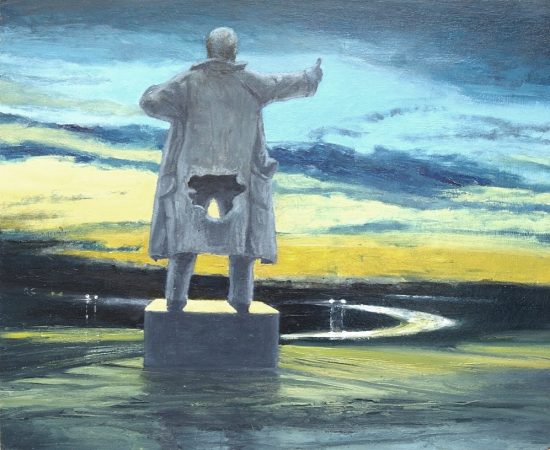
Andrew Frost: Can you talk about the way literalism and metaphor work in your pictures? In one way, read literally, these are very surreal or science fictional images, yet they also seem to be richly metaphorical.
Steve Warburton: I try to shy away from being too literal. I prefer not to give away too much so the viewer can explore the work in their own way – if they feel inclined – drawing their own conclusion. I’m no expert in the psychology of it but if a work is overtly literal, I’d expect the viewer to look and move on quickly, whereas if it’s challenging in some way I’d expect them to stand longer, taking it in.
I feel metaphor plays a role in this thinking. Making works enigmatic gives them more to offer.
Looking at Australian artists who work this way, Amor, Gleeson, Hearman, Tucker etc, their works hold your attention. They give you a rope to grab and then pull you in. The metaphor in my works is provided by the main object in the space. It is the enigma which hints at the pros and cons (mostly cons) of modern society. I suppose there are literal elements to my work. Quite often the figures are literal. They are usually portraying the average person, filling a space within the space. Their job is simple – to be there and perform.
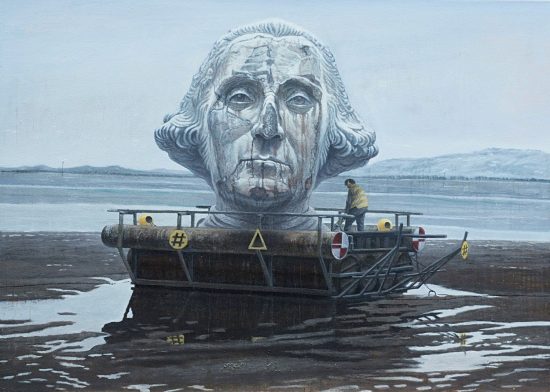
AF: How do you develop your pictures? What’s the process of making them? It feels like there’s a big element of visual research that goes into their final form.
When starting a new series, I’ll have a fair idea of what I want out of it – the general imagery as well as the physical look. When working these elements out in my head, I’ll sometimes look at older works for inspiration if they share themes. I also visit Google images or old photos I’ve taken which suit the theme. Sometimes I find inspiration close to home – a road, a landscape, a construction site or a figure. Now that all phones have cameras, it’s easy to get reference material when out and about. On occasion, I’ve stopped the car when I’ve seen something I can use. For the machine pieces of 2005-07, I used actual car parts for reference. I still have them.
The current works have grown from a series of works I produced in the 00’s. The big machinery parts paintings – Wasteland, If metal had memory, Tilting the herd. Recently, I felt like I hadn’t finished with these themes. I came across the idea of replacing the machine parts with large sculptural heads to give them a human element.
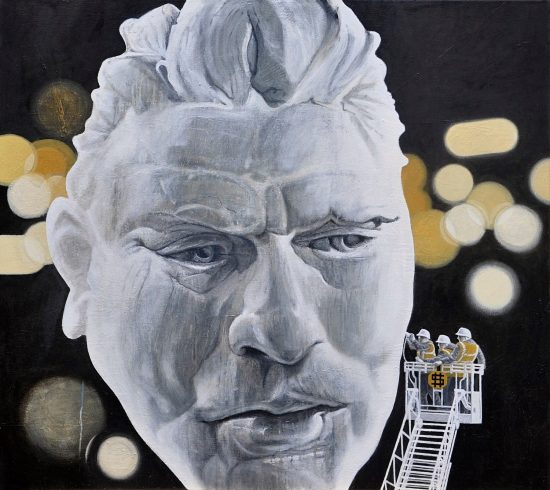
As for the process, I usually go straight to the final painting. I like the piece to have input into its evolution. For me, it doesn’t feel right to prepare too much. I like to get stuck in and see where it goes. When my vision is clear, it’s a smooth ride. Some works like to battle – sometimes I win and sometimes I don’t. With the current show, there were about 5-6 large works that didn’t get to being finished. If they’re not working for me, that’s it for them. I’ll take what I’ve learnt and move on.
The paint itself is just as important to me as the image. I love the process of painting. How it feels to move the paint around on the surface, those surprising little accidents that happen.
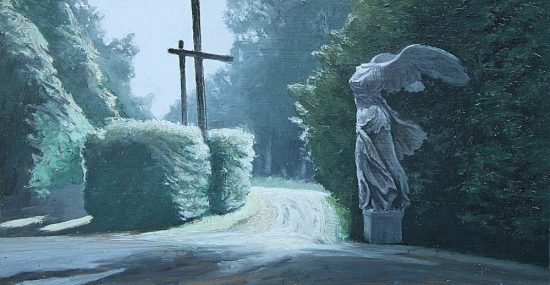
AF: What’s the role of history in these pictures?
SW: I’ve always had an interest in history and how it affects events later down the track – even looking at my own life and decisions I’ve made in the past and how they shaped my path through life. In ‘Alternative Facts‘, my latest show, history is an important lead to the narrative. Referencing past leaders like George Washington is a metaphor to how I see the problems occurring in today’s society – USA in particular. Using George Washington as a sculpture in a state of decay references Trump. Both are admired by millions, though I imagine if the 2 groups came together, they’d be at odds. Decaying George shows how I’d imagine he’d feel if he saw what had become of America.
The use of Capt. James Cook in one work references the feelings many have for the current political climate in Australia. I find these monuments interesting in that they represent historical values of a past – often in conflict.
Lately, the position of monuments in society has become problematic. Their initial purpose was to be a symbol of winners. Recently, they have been removed, toppled and even partially destroyed by demonstrators who have opposing opinions to what they stand for. Over time, society’s need for monuments providing a link to a battle, war or political belief may alter and bring the monument’s position into question.
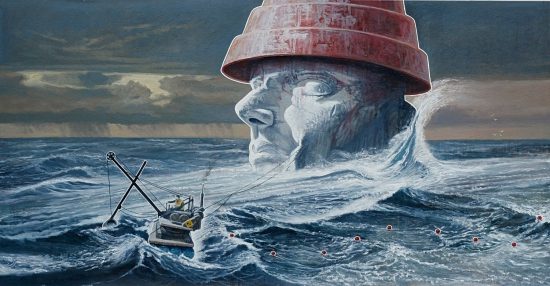
AF: What’s more important in your work – a sense of ambiguity? Or a definite suggestion of mood?
SW: Mood has always been important in my work. I like the viewer to feel something and then go away with an emotional response. Having said that, ambiguity is also important. I don’t like being too obvious with my imagery. I think mood and ambiguity can co-exist well together. Climate, both environmental and socio-political can affect the way we interact in society, Also, how we express ourselves. Maybe coming from Melbourne, it could be something that seeps into your bones.
AF: Your work seems to fit into a strong Australian tradition of this kind of painting – you mentioned Rick Amor. How do you see yourself in terms of an Australian context?
SW: Thank you. It’s interesting that you say this. I have always been a fan of Rick Amor, since I was studying at Monash. His work spoke to me the first time I saw it. I like his sense of place, his light and mood – his often dark narrative. Also, the feeling of isolation.
There is no intention on my behalf to be traditionally “Australian” in what and how I paint. I don’t know really if any Australian artist seeks out to be “Australian”? Though, having said that, artists are part of a community of like minds – a sort of “collective consciousness” maybe…
Steve Warburton, Alternative Facts, Tacit Gallery, Melbourne, May 15 to June 9, 2019.

I love these for many reasons but one that surprises me is that the calm nature of them leaves me at ease to absorb them with repeat and prolonged viewing. The topics raised may be emotive but the works themselves don’t scream at me.